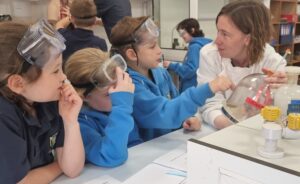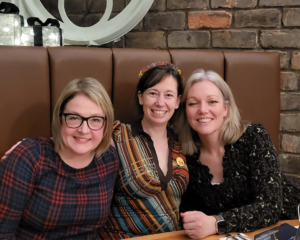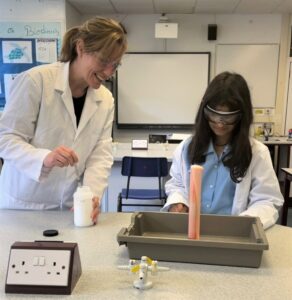To mark the International Day of Women and Girls in Science on Saturday 11 February, we interviewed three of our female science teachers who have completed PhDs, to learn what encouraged them to pursue various scientific career paths, and how that then led to a career in teaching. We hope you are as fascinated and intrigued as we were, to discover so much about our talented and passionate teachers.
Doctor Louise Bowen – Teacher of Biology and Chemistry
I applied to Dundee University to study Biochemistry and Physiology but in my second year, I fell in love with microbes. All other fields of biology that I had exposure to were very limited in focus. By studying microscopic organisms, I could still learn about their behaviour, biochemistry, ecology etc. It gave me the opportunity to learn about infections and immunity, which I found really interesting. In my final year, I completed a research project looking for antibiotic resistant genes in bacteria from India, and it was in doing this that I realised I needed to continue with research to the next level. In addition to this in my final year, I happened to see that microbiologists can work for the British Antarctic Survey (BAS), abseiling into new ice crevices to sample ancient ice! I emailed the microbiologist at BAS to ask how I could get where he is, and he told me I needed to get a PhD in bioremediation – so that was my next goal!
 Unfortunately, the ideal PhD project didn’t present itself, so instead I chose to stay at Dundee and do research funded by the nuclear industry. They wanted to know if we can use fungus to help clean old nuclear buildings, so I worked for three years collecting data to answer their question. I found that my PhD was a rollercoaster of emotions: thrilling and frustrating – there was a constant need to independently problem-solve your way through experiments and results. I was lucky to have been nudged into undergraduate teaching by a lecturer, an inspiring woman in science, Hilary-Kay Young (thank you, wherever you are!). I worked in the labs supporting professors in practical sessions and it was in one of these sessions that three women – who had originally signed up for Psychology – told me that I inspired them to convert to Microbiology and that I should consider being a teacher.
Unfortunately, the ideal PhD project didn’t present itself, so instead I chose to stay at Dundee and do research funded by the nuclear industry. They wanted to know if we can use fungus to help clean old nuclear buildings, so I worked for three years collecting data to answer their question. I found that my PhD was a rollercoaster of emotions: thrilling and frustrating – there was a constant need to independently problem-solve your way through experiments and results. I was lucky to have been nudged into undergraduate teaching by a lecturer, an inspiring woman in science, Hilary-Kay Young (thank you, wherever you are!). I worked in the labs supporting professors in practical sessions and it was in one of these sessions that three women – who had originally signed up for Psychology – told me that I inspired them to convert to Microbiology and that I should consider being a teacher.
I didn’t complete my teacher training straight after my PhD; I did observe a few lessons in a school and taught English in India but decided to work in industry. I started working for a large company producing microbiological products in their compliance department. I was testing the stability of important diagnostic products, to ensure that they maintained integrity for the duration of their advertised shelf-life. I was involved in auditing specific processes, ensuring that they were carried out in the same way site wide. Many people found this role boring, but it suited my personality as it involved working with lots of different people and good attention to detail. I really enjoyed it but after a year I felt it was time for a change, so I spent another week observing in a school, and this time I knew teaching is what I wanted to do.
Doctor Gillian Rodden – Teacher of Biology and Chemistry
 My degree was in Chemistry with German. Most people think this is a weird combination but as I invested a lot of time into learning languages, I didn’t want to drop those subjects completely. Once I knew I had the offer from Heriot Watt University in Edinburgh, I packed my bags and headed across the Irish sea to Scotland. The third year of my degree was spent in Marburg in Germany at the Philipps Universität. I started independent research during the year abroad and it was at this point that I started to study the properties of plastics and polymers. The final year of my degree included a dissertation project on selective reflection of light using the liquid crystal properties of cellulosic polymers. I worked for one of the most well-known materials science professors in Scotland, Professor JMG Cowie.
My degree was in Chemistry with German. Most people think this is a weird combination but as I invested a lot of time into learning languages, I didn’t want to drop those subjects completely. Once I knew I had the offer from Heriot Watt University in Edinburgh, I packed my bags and headed across the Irish sea to Scotland. The third year of my degree was spent in Marburg in Germany at the Philipps Universität. I started independent research during the year abroad and it was at this point that I started to study the properties of plastics and polymers. The final year of my degree included a dissertation project on selective reflection of light using the liquid crystal properties of cellulosic polymers. I worked for one of the most well-known materials science professors in Scotland, Professor JMG Cowie.
I continued the cellulosic polymers work for my PhD, which was sponsored by Courtaulds Coatings in Gateshead, looking into using these polymers as a potential heat rejection film to reject infrared radiation.
After my PhD, I transitioned into industrial work. My first job was working for a small company that was a spin-out from Heriot Watt University. I researched materials that could be selected based on their refractive index to form polymer waveguides on silicon. After two years I moved into the medical device field. I worked for a company that made injectable hyaluronic acid supplements for injection into the knee joint, which was designed to mimic the synovial fluid in a joint and relieve pain. The same product was also used for injection into the anterior chamber of the eye during cataract surgery. During this time, I was also involved in designing written procedures to follow the legislation of designing a medical device and prepared much of the documentation required to gain approval to register the product for full CE mark.
I went back to working in university for a while and did some post-doctoral research. I focused on testing materials for their suitability for use in sub-sea cables used in the oil and gas field and trying to process the chitin from shellfish waste to use in plastic alternatives in the packaging industry.
After this, when I looked back at all the opportunities I have had, I felt that I had a lot to offer young people. I felt I could benefit them as a teacher of academic and scientific education but also to pass on experiences and be a role model for the scientific field.
Doctor Dot MacDonald – Teacher of Biology and Chemistry
I have always had an enthusiasm for science, trying to figure out how stuff (living and non-living) works, learning new things and delighting in experiencing those ‘ah ha!’ moments when the penny drops, and it all makes sense.
 My Honours project – part of my first degree in Physiology at Queen’s University, Belfast – gave me my first experience of scientific research. Supervised by Prof Graham McGeown, I investigated the role played by intracellular calcium ions in smooth muscle cells utilising fluorescent confocal microscopy. Spending days in a dark room with an enormous confocal microscope observing localised Ca2+-sparks and cell-wide Ca2+-waves was hard to beat! The project was awarded a prize by GlaxoSmithKline and I was excited to attend a glamorous Oscar’s style award ceremony in London to receive an elaborate trophy! Who knew that this could be the life of a scientist?!
My Honours project – part of my first degree in Physiology at Queen’s University, Belfast – gave me my first experience of scientific research. Supervised by Prof Graham McGeown, I investigated the role played by intracellular calcium ions in smooth muscle cells utilising fluorescent confocal microscopy. Spending days in a dark room with an enormous confocal microscope observing localised Ca2+-sparks and cell-wide Ca2+-waves was hard to beat! The project was awarded a prize by GlaxoSmithKline and I was excited to attend a glamorous Oscar’s style award ceremony in London to receive an elaborate trophy! Who knew that this could be the life of a scientist?!
I knew I wanted to continue in research; a new challenge, but what? This led me to Glasgow University and a 4-year M. (Res.) and Ph.D. programme funded by The Wellcome Trust. The appeal of this programme for me was the opportunity to spend my first year conducting a range of research projects in different laboratories investigating diverse aspects of ‘Molecular Functions in Disease’, before choosing one of these projects to extend for a further 3 years, working towards a PhD. I had the privilege of working in pharmacology (Prof Mandy MacLean), biochemistry (Prof Gwyn Gould) and immunology laboratories before choosing a PhD research project in the latter, under the supervision of Professor Maggie Harnett. This project required me to investigate the anti-inflammatory effects of a parasite product (ES-62) in treatment of inflammatory autoimmune (rheumatoid arthritis and lupus) and allergic diseases (asthma and nut allergy). My days consisted of cell culture and analysis of cytokines produced by dendritic cells and macrophages derived from models of disease – the interface where parasitology and immunology meet! The pinnacle of this experience was the opportunity to travel to Melbourne, Australia, to present the results of my research at an international conference.
Having spent some years in academia, I had learned a lot about different branches of biological science, myself, and ultimately what direction I wanted my career to take. The collaborative, communication and theoretical aspects of science, were the elements of research that I was drawn to. I loved learning and developing my understanding in all areas of science, and I discovered that sharing that experience with others made it all the more enjoyable. That is when a science teaching career became my goal and I have never looked back. The best bit is that now, I get to share those ‘ah ha’ moments with my pupils!
(Little known fact…Dr Rodden and I went to the same secondary school in Northern Ireland! What a coincidence we should end up teaching in the same school in Scotland!)
